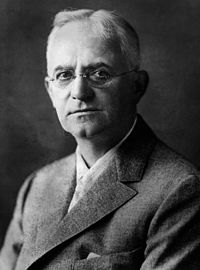Film Homepage Film Present Film Future Film Big Board Film Citations
Lights...Camera...Action!!!
Pre-Cinematic Era

The Filming industry can be traced back in the late 1400s’ starting with Leonardo DaVinci. Leonardo DaVinci theorized about creating a device that would reproduce reality. DaVinci never successfully developed his device but did draw it out, naming his paper invention, ‘The Magic Lantern’. Nothing was heard about his ‘Magic Lantern’ until the 1690s’ where Athanasius Kircher, a German inventor, took Da Vinci's Magic Lantern idea and brought it to life. "The Magic Lantern" was able to project images printed on glass plates through a continuous ray of light made by an oil lamp, a convex lens and a concave mirror.
 In the 1800s’ an English photographer named Eadweard Muybridge was contacted by the former California Governor Leland Stanford due to his reputation. The former California Governor Leland Stanford challenged Eadweard Muybridge to help prove that the four hooves of a running horse left the ground but could not be seen by the naked human eye. The challenge was accepted and experimented in 1872. By 1878 and 1884, Eadweard Muybridge proved that the four hooves of a running horse did in fact left the ground, captured by photographs. Ever since Eadweard Muybridge's accomplishment with capturing the racing horse in motion. He spent most of his remaining years publishing several books based on capturing motion and producing thousands of photographs of humans and animals in motion.
In the 1800s’ an English photographer named Eadweard Muybridge was contacted by the former California Governor Leland Stanford due to his reputation. The former California Governor Leland Stanford challenged Eadweard Muybridge to help prove that the four hooves of a running horse left the ground but could not be seen by the naked human eye. The challenge was accepted and experimented in 1872. By 1878 and 1884, Eadweard Muybridge proved that the four hooves of a running horse did in fact left the ground, captured by photographs. Ever since Eadweard Muybridge's accomplishment with capturing the racing horse in motion. He spent most of his remaining years publishing several books based on capturing motion and producing thousands of photographs of humans and animals in motion.
Technology That Made Film Possible
Thaumatrope
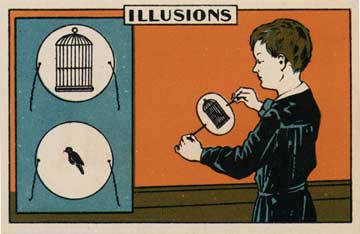 William Henry Fitton, Irish physician and amateur geologist, invented the Thaumatrope in 1824. The Thaumatrope is a two-sided card that has different images on them. At the ends of the card, it is usually tied with loose strings; twirling the loose strings , the images appear to be just one image (combination of both image). This creates the illusion of motion.
William Henry Fitton, Irish physician and amateur geologist, invented the Thaumatrope in 1824. The Thaumatrope is a two-sided card that has different images on them. At the ends of the card, it is usually tied with loose strings; twirling the loose strings , the images appear to be just one image (combination of both image). This creates the illusion of motion.
Zoetrope
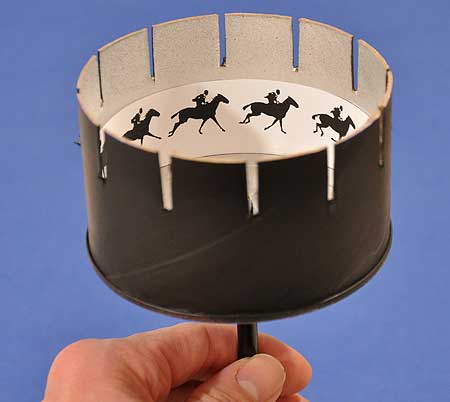 The oldest Zoetrope has been found in China, back to 180 AD, but it was re-invented by a British mathematician William George Horner in 1833. The Zoetrope is a cylindrical device that contains similar yet slightly different images inside. When the device is twirled, the device creates an illusion of the images being in motion.
The oldest Zoetrope has been found in China, back to 180 AD, but it was re-invented by a British mathematician William George Horner in 1833. The Zoetrope is a cylindrical device that contains similar yet slightly different images inside. When the device is twirled, the device creates an illusion of the images being in motion.
Kinetograph

The Kinetograph is an early motion picture camera, created in 1891 by William Kennedy Dickson, Scottish inventor. This camera came with rapid intermittent, or stop-and-go, film movement, to photograph movies for in-house experiments and, eventually, commercial Kinetoscope presentations. This creation was created by Dickson, but patented by Thomas Edison.
A Kinetoscope is a single-person viewing system, created in 1891 by William Kennedy Dickson, Scottish inventor, used to reproduce what was captured by the Kinetrograph. The Kinetoscope worked by creating the illusion of movement by conveying a strip of perforated film bearing sequential images over a light source with a high-speed shutter. This creation was created by Dickson, but patented by Thomas Edison.
Phantoscope Improvement To The Vitascope

In 1895, Charles Francis Jenkins and Thomas Armat invented the ‘Phantoscope’. The ‘Phantoscope’ was a projector that enabled filmstrips of long lengths to be projected without interruption on l
arge-screens (this hinted at the potential of movies as a future mass medium). But due to disagreements of copyrights, Charles Francis Jenkins and Thomas Armat went to Thomas Edison and made a proposal. Thomas Edison agreed with the proposal and decided to take the invention and recreate the ‘Phantoscope’ to the Vitascope. The Vitascope was short lived as Thomas Edison continued on with his research.
Cameras
Aeroscope
In 1910, Kazimierz Prószyński, a Polish inventor, created the first successful hand-held operated film camera, the Aeroscope. Kazimierz Prószyński created this film camera to reduce the hard effort of the film cameras before. The film cameras before were cameras that constantly needed to be cranked with both hands (almighty strength). The Aeroscope did not needed to be cranked because the film camera was able to be powered by compressed air. The only downfall was that the Aeroscope only lasts 10 minutes. This film camera still exists today except with a mast group of improvements and different names.
Celluloid
Celluliod was created by Alexander Parkes in 1855. Celluloid is a specific type of plastic that is used to make photographic films and many other objects (dominoes, billiard balls, etc). It is resistant to water, oils, and dilute acids. The Celluloid was a very experimental piece. As film inventors and photogrpahers all experimented with the celluloid. John Carbutt, English photographer, in 1879 developed emulsion-coated celluloid film sheets, which began to be used in the Edison experiments such as the Kinetroscope; it then became the starting point of the usage of the Celluliod in the film industry.
Cinematograph
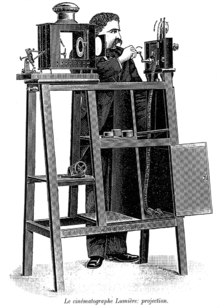
French brothers and inventors The Lumière, in 1894, decided to create a projection system more efficient than the Kinetoscope. This invention was a motion picture film camera, which also serves as a film projector and developer. The Lumière brothers made a tipping-point in the film industry, now many people could watch the projection. The Cinematrograph went all around the world, and it is said that is the beginning for film to become mass media (well-known).
Important Players
Thomas Edison

(February 11, 1847 – October 18, 1931) Thomas Edison was an American inventor and businessman. Thomas Edison was not aiming to be working in the Filming industry due to countless failures that occurred until he tasked his assistant to help create the Kinetograph. Then after, his interest in the creating of films, cameras, production, etc. was greatly increased. In Thomas Edison’s lifetime, he was able to patent /create 1,093 inventions. But not only was Thomas Edison an inventor, he was also a businessman. Thomas Edison had bought so many patents and copyrights, that he became the gateway for films. By becoming the gateway for filming (at a certain point), Thomas Edison created his filming company (studio), Trust, in 1908. With such power, Trust was able to refuse equipment to filmmakers and theatre owners for any reason. Until 1917, Trust’s breakup was too harsh to handle as some independent producers refused to agree to Trust’s terms.
The Lumiers
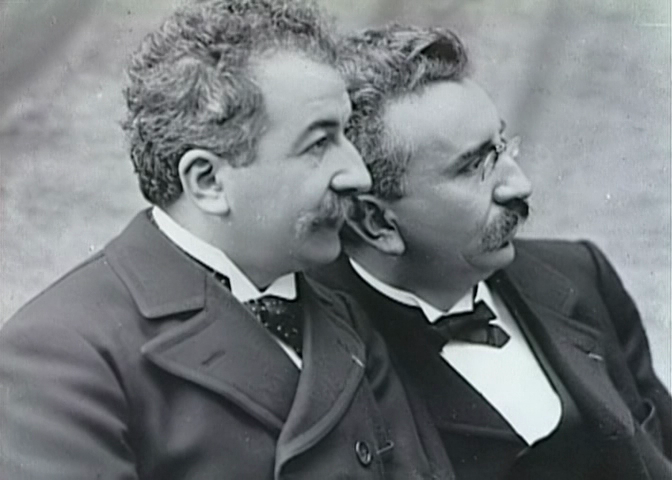
The Lumière brothers, Auguste (October 19th, 1862 – April 10th, 1954) and Louis (October 5th, 1864 – June 6th, 1948) are one of the earliest inventors, photographers, and film makers. The Lumière brothers begun their interest due to their Father, Antoine Lumière; a well-known artist who started a manufacturing and supplying photographic business. As Louis Lumière often experimented with his Father, he invented the ‘dry plate’ in 1881. The ‘dry plate’ invention was created for the convenience of photographers. The ‘dry plate’ eliminated the need for plates to be stored in a darkroom before and after exposure. In 1894, Antoine Lumière presented to his sons, Thomas Edison’s invention, the Kinetoscope, from his trips. He influenced his sons to recreate the Kinetoscope due to the success Thomas Edison had. The influence lead the Lumière brothers to creating the Cinematrograph (in 1895); a projection technology that shaped the pre-era of the film industry by presenting film(s) to more than one person, unlike Thomas Edison’s Kintescope. In 1907, the Lumière brothers invented the Autochrome Plate, the first practical color photography process. With the inventions to the film industry and with photography, the Lumière brothers are known for being the Fathers of the massification of film as a media.
George Eastman
(July 12, 1854 – March 14, 1932) George Eastmen was an American innovator and an entrepreneur who founded the Eastmen Kodak Company. George Eastmen became interested in filming (cameras) when he was 24 years old, preparing for a vacation. He brought himself, his own set of camera but was dissatisfied! George Eastmen was so dissatisfied with the weight and materials of the camera that he canceled out his vacation to reinvent the camera! He experimented at home for 3 years before he invented a successful dry plate formula with his patented machine that can prepare large numbers of plates (films). The first business store he opened up was in April 1880, the store was successful yet inspiring. George Eastmen started inventing for the public, something easy to carry and affordable! As his small business grew, he became the founder of the Eastmen Kodak Company in 1888; there he also invented the roll film that inspired inventions of motion picture film by the world's first film-makers Thomas Edison, the Lumière Brothers, Georges Méliès, etc. . .
Era Of Film
People say that Cinematrograph was the introduction of film as a mass media, but this massification wasn't complete until narrative films came into the scene. This is where Film success began as a mass media.
Narrative Film
In a short definition, Narrative films are movies that tell stories. Before narrative films came in the scene, static films made with immobile cameras were the only projections that people could see. Therefore, French magician and inventor Georges Milies opened the first public movie theater in France in 1896 because he believed that a movie was not simply a means of recording reality. He believed that a movie could be artificially planned and controlled like a staged play. He made changes to movie scripts, he knew that movies shouldn't be just show reality, but tell a story. This modifications were made by using editing and existing camera tricks and techniques, such as slow motion and cartoon animation which became key ingredients in future narrative filmmaking. As Edwin S. Porter, a cameraman who studied George Melies idea in the Edison’s lab, adapted the idea and created America’s first narrative film.
One of the most known first narrative film made by Melies is "A trip to the moon" in 1902. This film is now an iconic production of film-making and is considered a masterpiece.
Edwin S. Porter, cameraman, was the first American filmmaker that studied Melies techniques. His most successful film was "The Great Train Robbery" in 1903. This film was the introduction to western genre and as well chase scenes.
Distribution Of Film
Movie Theater & Nickelodeons
Movie theaters came into play in the late 1800s. Movie theaters replaced personal usage of motion picture audiences; known as nickelodeons. Nickelodeons` a form of movie theater whose name combines the admission price with the Greek word for “theater.” The films produced and reproduced in movie theaters were news, documentary, comedy, fantasy, and dramatic shots, all of which they lasted about an hour. The films were all silent films, so there were theater operators and piano players that were used to create actual live sound effects; examples: gun shots, thunders, theme, dramatic music, etc. Nickelodeons spread quickly because the silent films were able to transcend language barriers. Thus leading to many immigrant viewers who struggled to learn English and who wanted a cheap way to have fun. By 1910, Nickelodeons reached their peak, when entrepreneurs began to seek more affluent spectator, attracting them with larger and more lavish movie theaters. Movie theaters hit the jackpot and became a major industry.
Rise of Hollywood Studio System
In 1908, Thomas Edison forms the Motion Picture Patents Company, Trust. Trust was made up of major US and French film producers who wanted to have full control of the film’s major technologies and film distributions; becoming a very strict and expensive term. Many independent producers refused Trust’s terms due to the terms being too expensive and too demanding. To the independent producers, contracting with Trust was a contract that caged and sucked the living life out of you. So many independent producers relocated themselves; some of those producers that relocated actually snuck in and out of Mexico to stay out of trouble with Trust!
End of Trust and the rise of the Oligopoly
With the filming industry’s power falling under Trust’s hand, two Hungarian immigrants, Adolph Zukor, who found Paramount Pictures, and William Fox, who found Twentieth Century Fox, found a way to bypass Trust. Adolph Zukor’s and William Fox’s bypass Trust’s rules, creating an intense breakup of the filming industry’s power in 1917. Adolph Zukor found a way to bypass Trust as William Fox suited Trust. Adolph Zukor understood what depended on what in the filming industry: production, distribution, and exhibition. This control over the three levels is known as vertical integration. This vertical integration gave great power to some studios, which they controlled the bulk of the business, known as Oligopoly.
Production
Adolph Zukor understood production was not only about making films, but also giving importance to actors. Adolph Zukor's idea was to control the production not through patents, but through contracts with actors. He hired a number of popular actors and formed the Famous Players Company in 1912 to compete against Trust. From there his famous actress, Mary Pickford, broke free from his contract in 1919 and opened up her own company, United Artists. Who was then later joined by actor Douglas Fairbanks, Charlie Chaplin and director D.W.Griffith. In 1920, director Thomas Ince and his company, Triangle, emerged introducing the studio system; an assembly-line process of movie-making were actors, directors, editors, writes, and others all worked under exclusive contracts for the major studios.
Distribution
Adolph Zukor led the fight to distribution due to Trust’s strict guidelines. He developed block booking distribution, a system of selling multiple films to a theater as a unit, gaining access to popular films with big stars like Mary Pickford, exhibitors had to agree to rent new or marginal films with no stars. Adolph Zukor realized that by selling his films in packages, a movie theater that wanted one of his A-pictures could be forced to buy several inferior B-pictures. This created a guaranteed market for even the most mediocre studio films, as theaters were compelled to buy the films sight-unseen. Another distribution strategy involved the marketing of American films in Europe due to World War I. World War I, the once-powerful European film industry was disrupted, only the U.S were able to meet the demand for films in Europe. The war made the U.S leader in the commercial movie business worldwide. This war was a key event to made Hollywood dominate the world market even today.
Exhibition
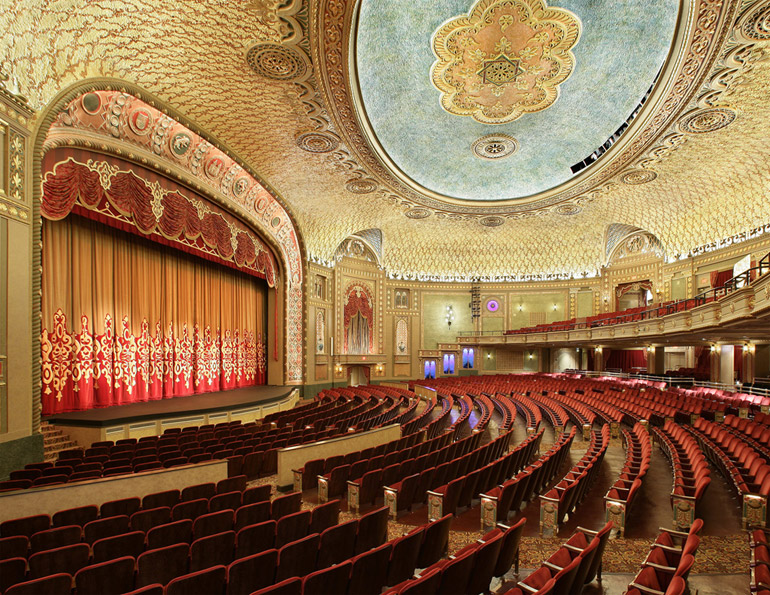
With the financial crisis for Trust after the bypasses that damaged them, Trust collapsed on March 30, 1918; where Thomas Edison sold the company to the Lincoln & Parker Film Company. By 1925, Adolph Zukor gained majority of the filming industry power by the usage of production, distribution, and exhibition and with Paramount and Publix (the country's largest theater chain) merging, giving Adolph Zukor a lot of influence over movie exhibition. Adolph Zukor and other studio producers then created another strategy in the filming industry; by owning the first-run theaters; being able to generating 85 – 95 % of the film revenue. So instead of buying all the theaters, it would be better to own the first-run theaters (15% of the nation's theaters), which they would exhibit new premium films in major downtown areas, in front of large audiences.
In order to earn revenues from the first-run theaters, the studios would have to draw middle and upper-class audiences to the movies. In order to do this they made movie palaces, which are full-time single screen movie theaters that came along with elaborate architecture and elegant decor.
 In order to attract the urban and suburban middle class, the studios developed the mid-city movie theaters. These movie theaters were built in convenient locations near urban mass transit stations. This idea is still going on today more known as multiplexes.
In order to attract the urban and suburban middle class, the studios developed the mid-city movie theaters. These movie theaters were built in convenient locations near urban mass transit stations. This idea is still going on today more known as multiplexes.
In the late 1920s, a vertical integration was established among the filming industry; mainly involving small competitive firms, Paramount Pictures, MGM, Warner Brothers, 20th Century Fox, RKO, Columbia, Universal and United Artists. Those small firms became powerful firms that had a strong control over the movie business, divided into two groups, Paramount Pictures, MGM, Warner Brothers, 20th Century Fox, and RKO were known as the Big Five. The Little Three were also created, involving the remaining: Columbia, Universal and United Artists firms/studios. These studios conformed a powerful Oligopoly, making it more difficult for independent companies to succeed.
World War I
The World War I, or more known as the First World War, was a global war centered in Europe that began on 28 July 1914 and lasted until 11 November 1918. This war was a key event in the film industry. Europe, before the war, was leading the film productions, but after the war many film country producers such as France, Germany and Italy were struggling due of the economic crisis that the war brought; therefore, the U.S took Europe leadership in film making. This supremacy was worldwide, and still today, the U.S it's the leader in the film industry, been Hollywood the film capital worldwide.
Silent Era
The Silent Film Era began in 1895 and ended around 1929. The Silent Film Era was an era of the filming industry that contained mainly motion but has additional features such as sound for dialog and titles edited in to clarify the on-screen situation. The films were short, only a few minutes long. As sound recordings in filming did appear in the 1920’s but were only experiments. During the experimenting of the Silent Era, the filming industry was able to create new genres such as mysteries, comedies, horror films, science fictions, ect. With the new knowledge to the filming industry, it moved from a novelty entertainment to a stronger social media form (Hollywood star system, movie reputation, etc).As you can see on the right; Charlie Chaplin is a famous icon of the Silent Era. His shows were able to portray the effects of the Silent Era of the Film industry.
Blockbuster
 Blockbuster is something that sustains widespread popularity and achieves enormous sales. The first blockbuster to occur happened in 1915; when the controversial film, The Birth of a Nation was released. This was a key term for the film industry, the base to invest in the production of movies, which some times could lead to spend millions of dollars.
Blockbuster is something that sustains widespread popularity and achieves enormous sales. The first blockbuster to occur happened in 1915; when the controversial film, The Birth of a Nation was released. This was a key term for the film industry, the base to invest in the production of movies, which some times could lead to spend millions of dollars.
Introduction of Sound
The introduction to sound dates back to Thomas Edison in the 1890s when he experimented to link his phonograph with his motion pictures but failed. In 1910s, Bell Labs, an AT&T research arm, produced prototypes of loudspeakers and amplifiers, which was continued into the Warner Brothers' studios in the 1920s with far more intense research. As the Warner Brothers' were experimenting with sound, Fox was also experimenting with sound. So in the 1927, the Warner Brothers were able to successfully produce, The Jazz Singer as an experiment! It became first feature-length motion picture with synchronized. But Fox, too, was able to successfully release their sound-film newsreels; capturing the sound of the takeoff and return of Charles Lindbergh.
And colors arrived to the scene
Movie Genres
Between the 20s and the 30s , while movie was going into modifications by incorporating sound and color, new genres started to appear and old ones make an evolution thanks to color and sound. This genres were: gangster films, musicals, newspaper-reporting films, historical biopics, social-realism films, lighthearted screwball comedies, westerns and horror, between others that came along.
The Great Depression
In the United States, the Great Depression began soon after the stock market crash of October 1929, which sent Wall Street into a panic and wiped out millions of investors. Consumer spending and investment dropped, causing steep declines in industrial output and rising levels of unemployment as failing companies laid off workers. By 1933, 13 to 15 million Americans were unemployed and nearly half of the country’s banks had failed.
The Great Depression affected nearly all of the Hollywood studios. Studios had to reorganize, request government assistance, cut budgets and employees, and close theaters when profits plummeted. Attendance at theaters was drastically affected, although during even the darkest days of the Depression, movie attendance was still between 60-75 million per week. Special incentives and giveaways (such as 2-for-1 features, dish nights, and other contests and attractions) helped to maintain a patronizing audience. The balancing act for film-making was to both reflect the realism and cynicism of the Depression period, while also providing escapist entertainment to boost the morale of the public by optimistically reaffirming values such as thrift and perseverance (without offending the censors).
WWII
World War 2, also known as the Second World War, was a war fought from 1939 to 1945 in Europe and, during much of the 1930s and 1940s, in Asia. It was the largest armed conflict in history, spanning the entire world and involving more countries than any other war, as well as introducing powerful new weapons, culminating in the first use of nuclear weapons. World War II produced about 50 million deaths, more than any other war to date.
The movie industry responded to the national war effort by making movies, producing many war-time favorites, and having stars (and film industry employees) enlist or report for duty. The US government's Office of War Information (OWI), formed in 1942, served as an important propaganda agency during World War II, and coordinated its efforts with the film industry to record and photograph the nation's war-time activities. Films took on a more realistic rather than escapist tone, as they had done during the Depression years of the 30s. Some of these films consisted of Casablanca, Once upon a Honeymoon, and The Best Years of Our Lives.
The American propaganda, by the US government's OWI and film studios, was framed in order to incentive patriotism, and drives child to grew up thinking what side is good and wrong, and finally inculcating the idea to be part of the militia when they could reach an specific age.
The Cold War
The Cold War was a long period of tension between the democracies of the Western World and the communist countries of Eastern Europe. The west was led by the United States and Eastern Europe was led by the Soviet Union. These two countries became known as superpowers. Although the two superpowers never officially declared war on each other, they fought indirectly in proxy wars, the arms race, and the space race.
The House of Representatives' Un-American Activities Committee (HUAC), formed in the American congress, began investigating Hollywood for alleged subversive and communist ties. This witch hunts was very aggressive, which leaded to restrict the content of film, and in many ways they intended to frame the movies by the same ways they did within WWII.
The Paramount Decision
While the House of Representatives' Un-American Activities Committee (HUAC) was doing an aggressive witch-hunt, the American government was also aggressive regarding business practices. Mid 1940’s the government increased its scrutiny of movie industry’s aggressive business practices; demanding that the major companies, Paramount, Warner Brothers, Twentieth Centruy Fox, MGM, and RKO, known together as “The Big 5”, end vertical integration; so they stop having full control over movie production, distribution and exhibition in the filming industry. The United States Supreme Court ruled the elimination of block-booking and blind buying, which in other words means the end of the control over the exhibitions within the movie business. The court decision over "The Big 5" marked the end of the Studio system. Yet nothing really changed because the consumer demand was still high.
Television Changes Hollywood
Home Entertainment
Cable TV
While televisions were invading most of the American homes, movie industry had to adapt to this huge change. Home Box Open (HBO) was the first pay/premium television channel. In 1975, HBO was the first in the television industry to use satellites for regular transmission of programming . This was an asset for the movie industry. Hollywood realized that it could increase its profits by advertising its new releases on television - first shown to be successful with the massive TV marketing campaign (of $700,000) for Jaws (1975) - the film was also booked into almost 500 theaters for its opening weekend.
VCR/VHS
Ampex in 1963 offered the first consumer version of a videotape recorder, but their prices were too high making no success. in 1972, the AVCO CartriVision system was the first videocassette recorder to have pre-recorded tapes of popular movies (from Columbia Pictures) for sale and rental, but the company last only one year. Then, in 1975 the appearance of Sony's Betamax (the first home VCR or videocassette recorder) in 1975 offered a cheaper sales price of $2,000 and recording time up to one hour; this led to an increasing sells.
In 1978, Philips introduced the video laser disc (aka laserdisc and LD) -- the first optical disc storage media for the consumer market; Pioneer began selling home LaserDisc players in 1980; eventually, the laserdisc systems would be replaced by the DVD ("digital versatile disc") format in the late 1999.
Introduction to the Digital Age
In the 90s VCR were still dominating in the movie industry, and video rental stores started to been known, such as Blockbuster Entertainment. In 1990, Kodak introduced the Photo CD player. This was the beginning of the digital Age.
By 1997, the first DVDs (digital video discs) had emerged in stores, featuring sharper resolution pictures, better quality and durability than videotape, interactive extras, and more secure copy-protection. In just a few years, sales of DVD players and the shiny discs proliferated and would surpass the sale of VCRs and videotapes. Also, in the earliest 90s Internet was introduced to the mass, and also affected the film industry.
(Click on the Present link to find out what is currently happening in the film industry)

